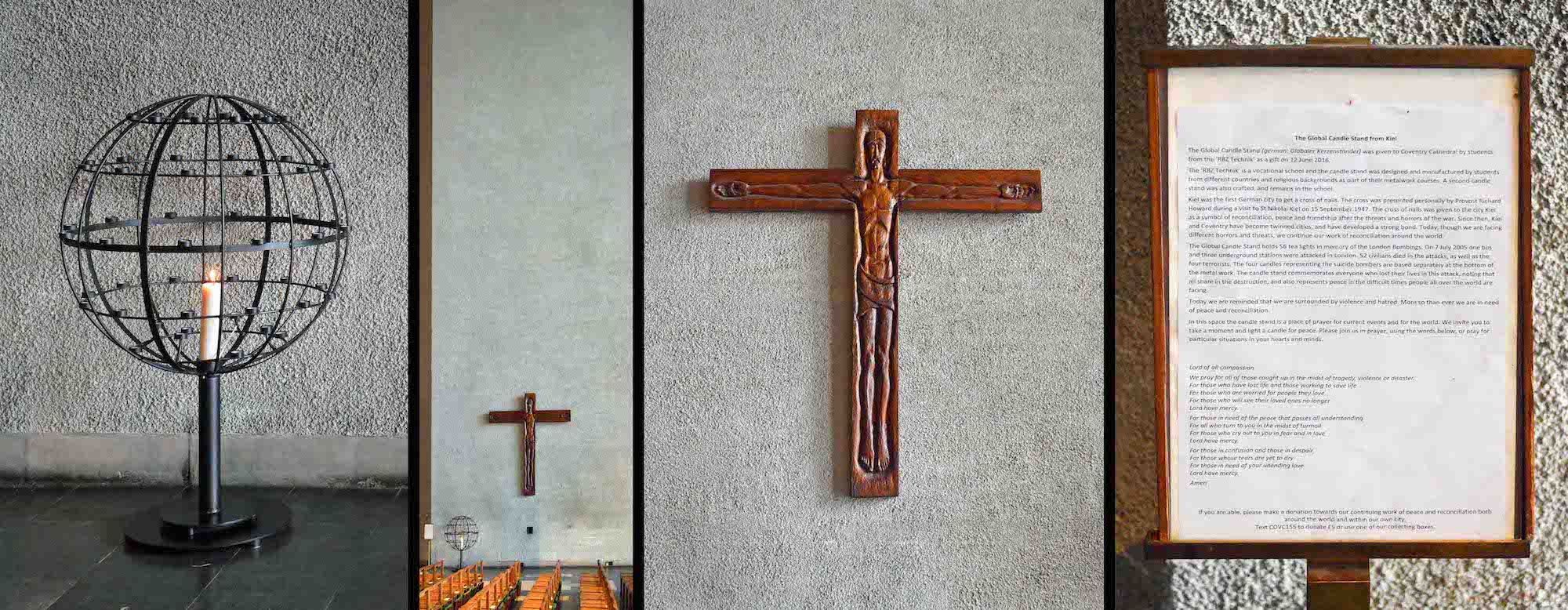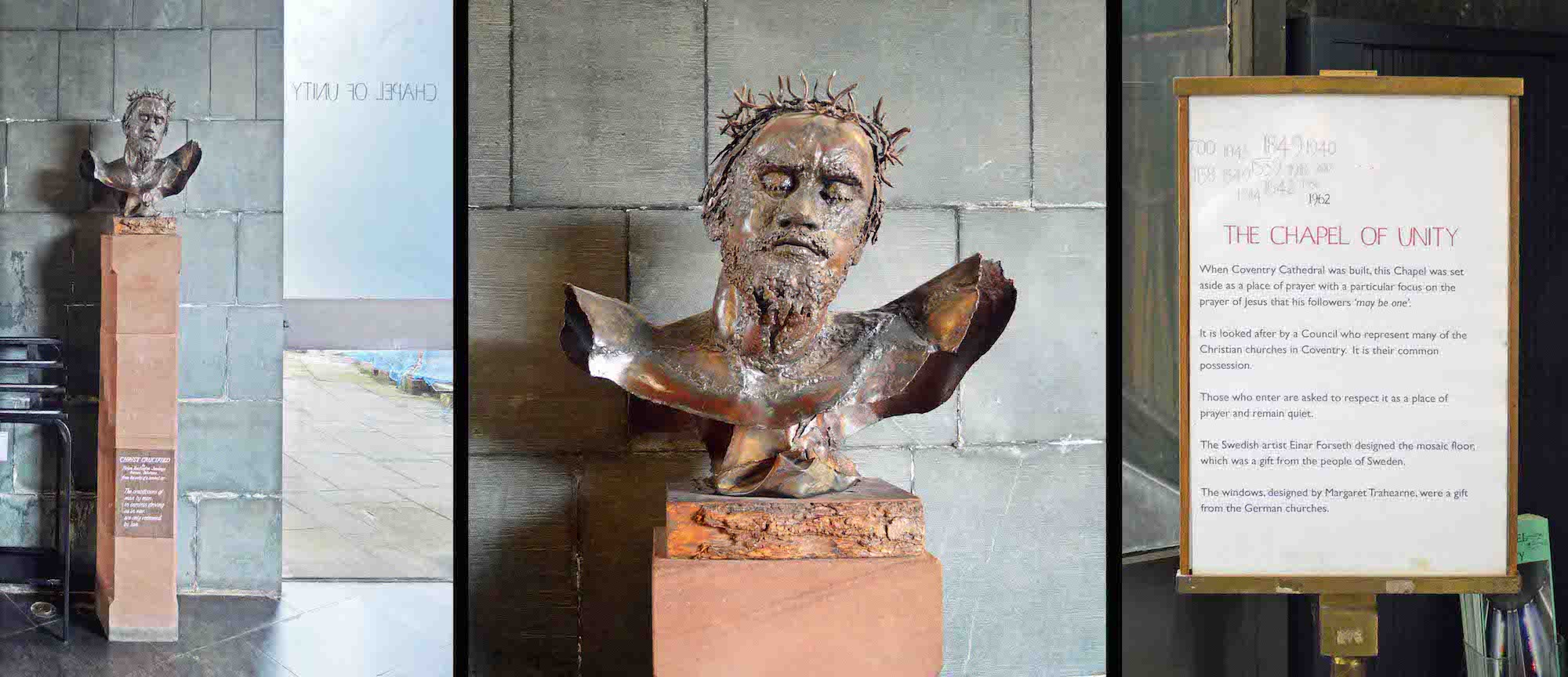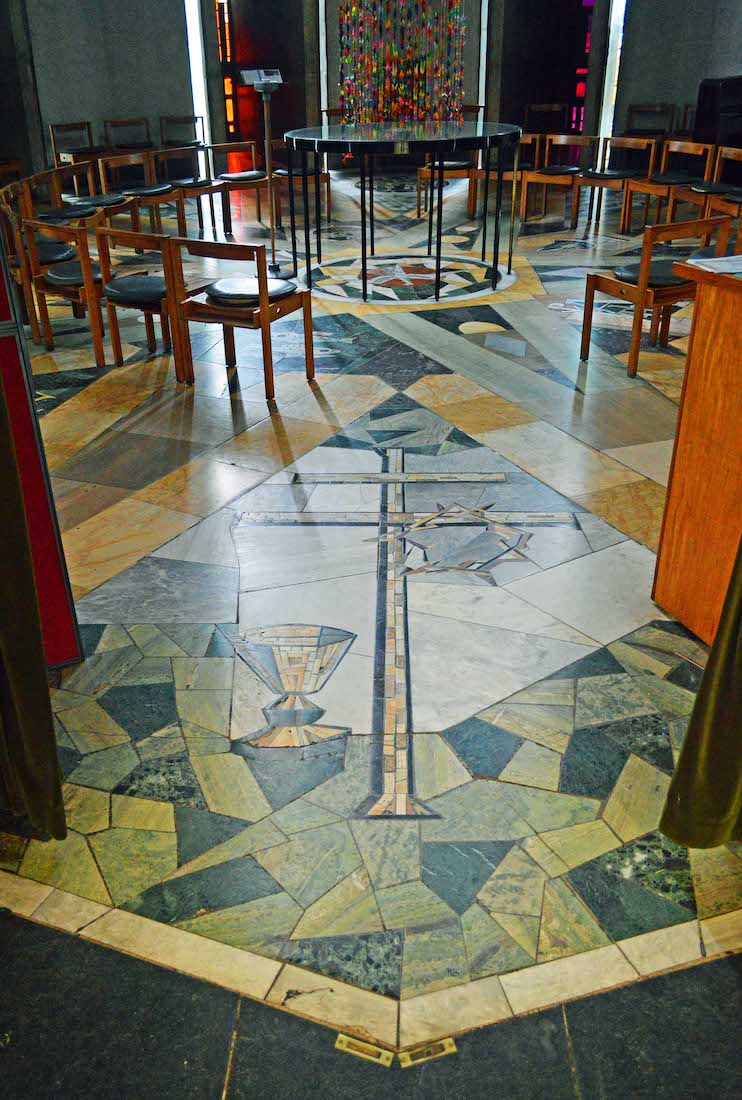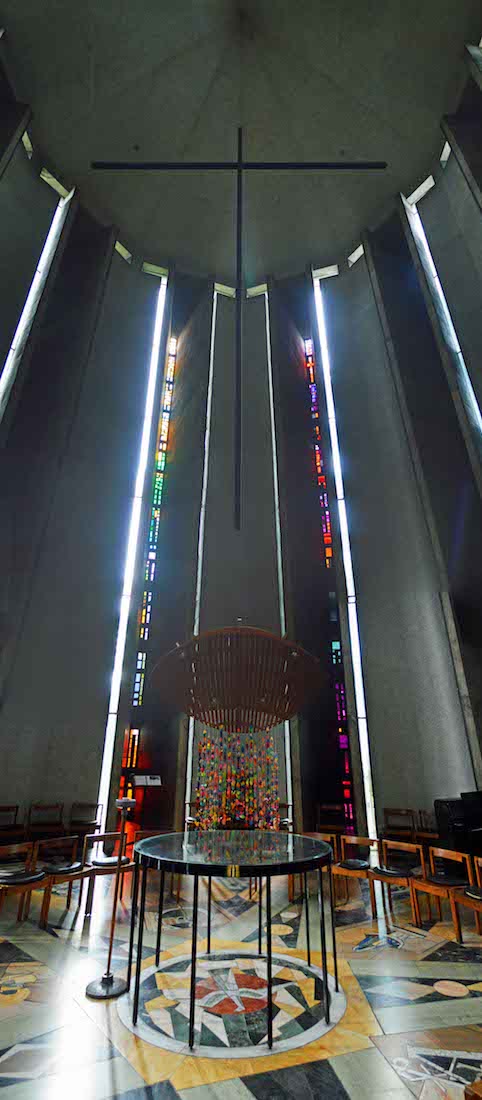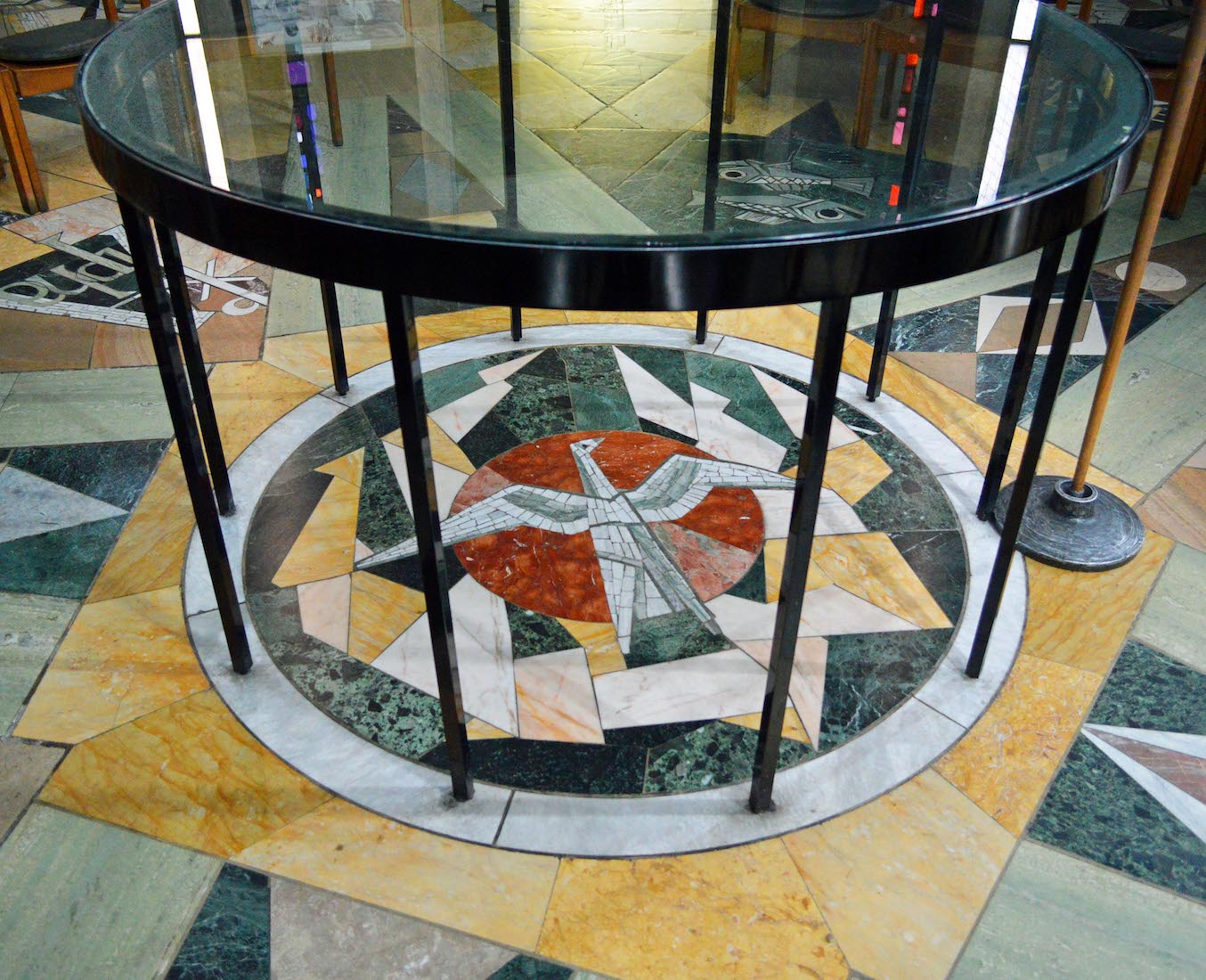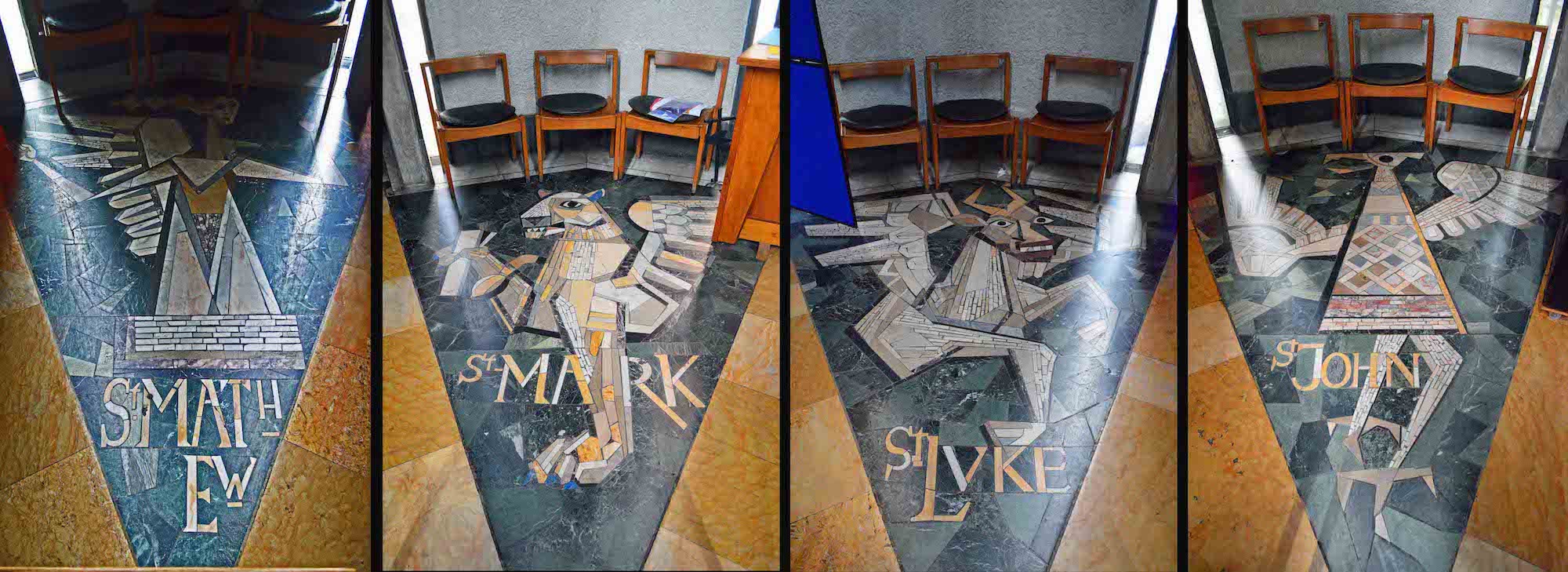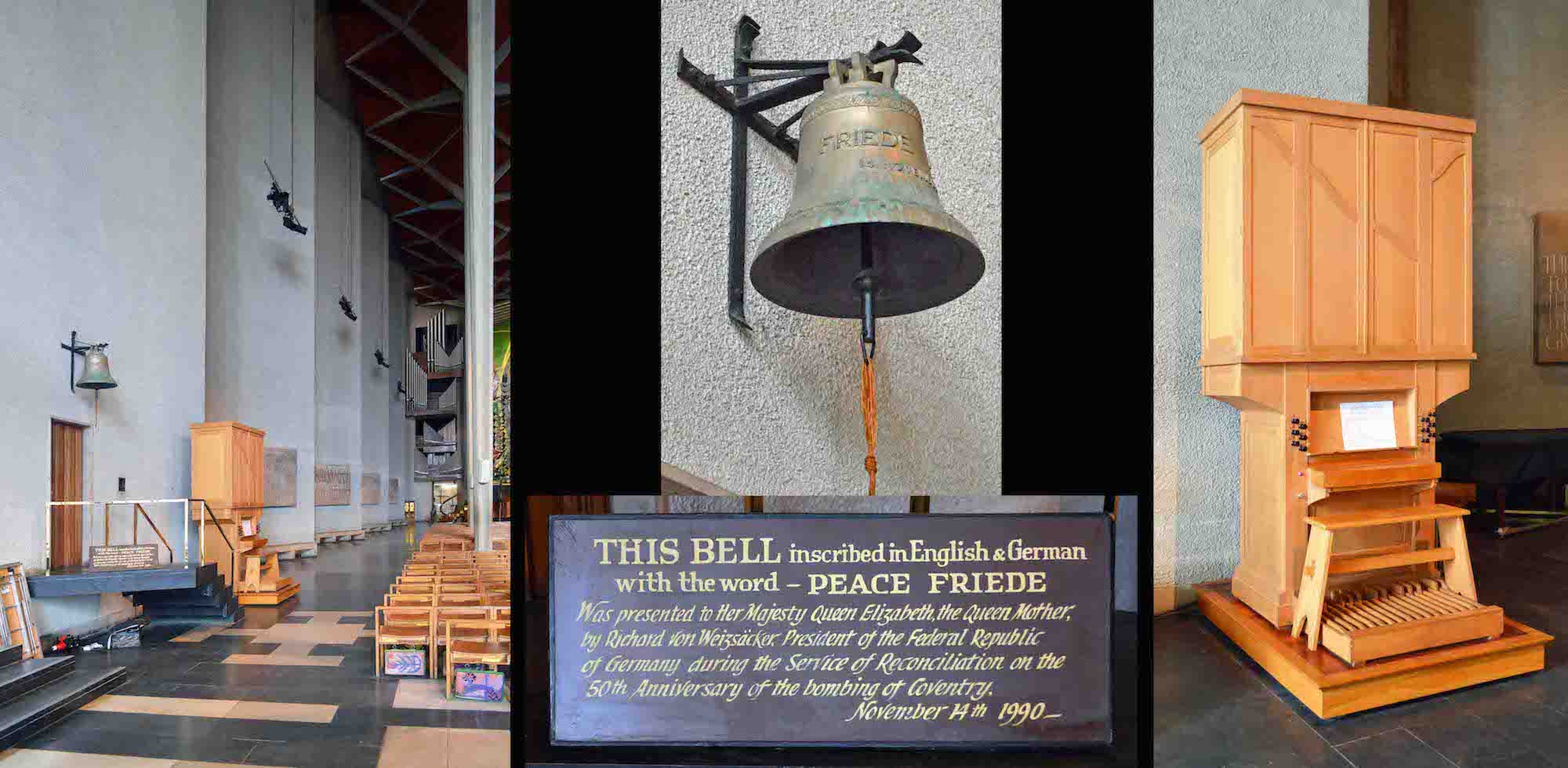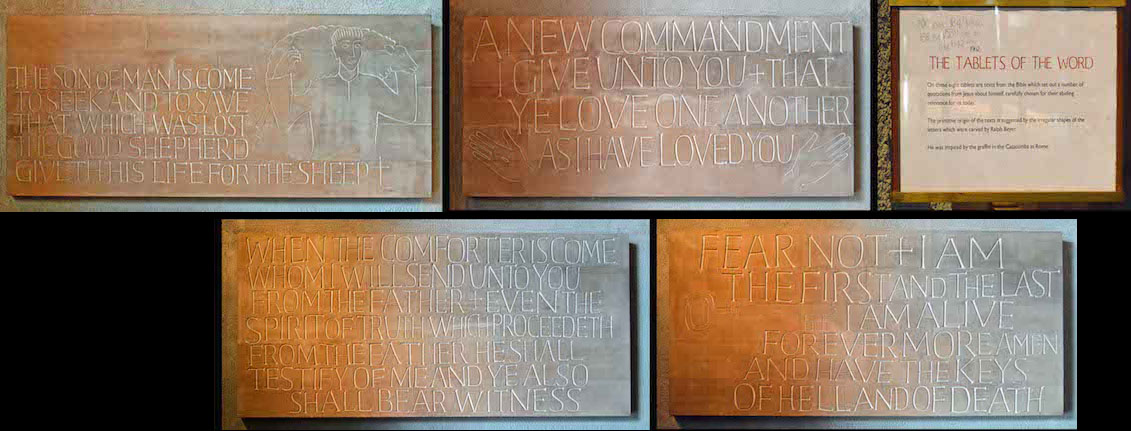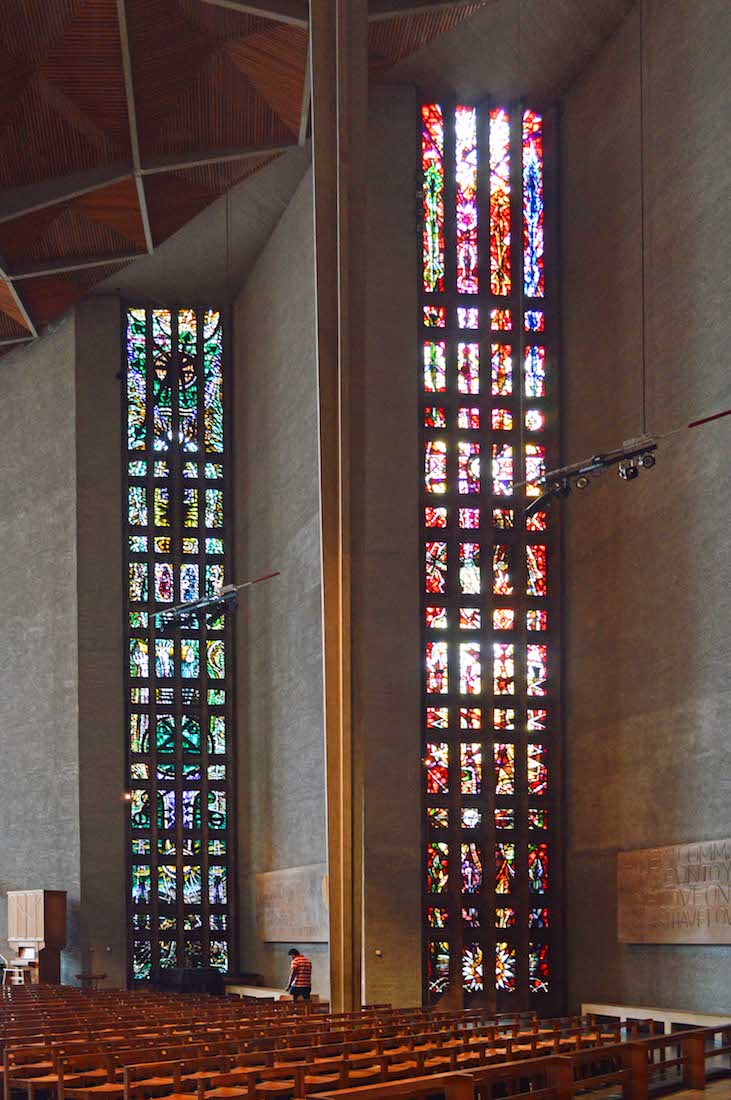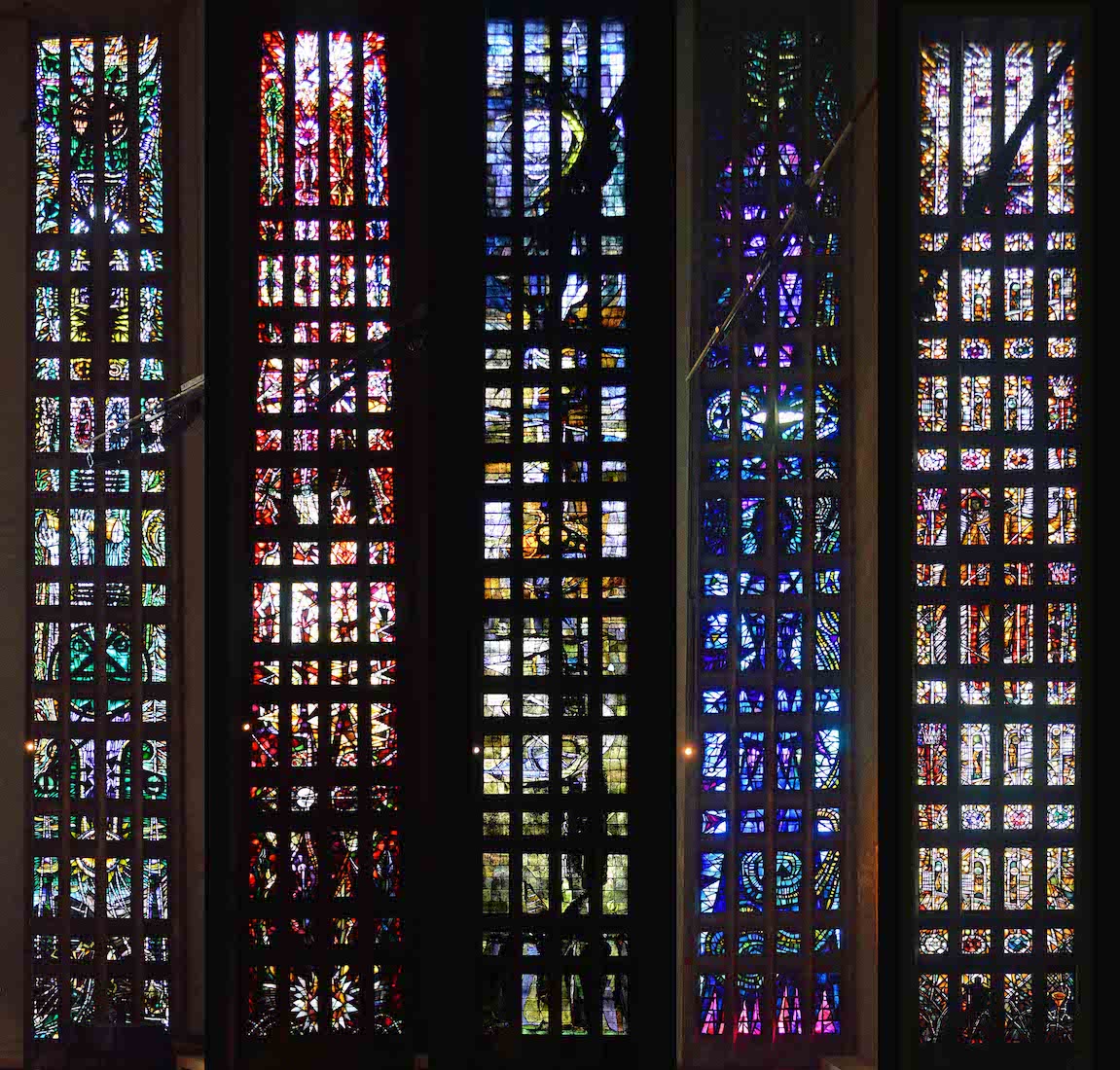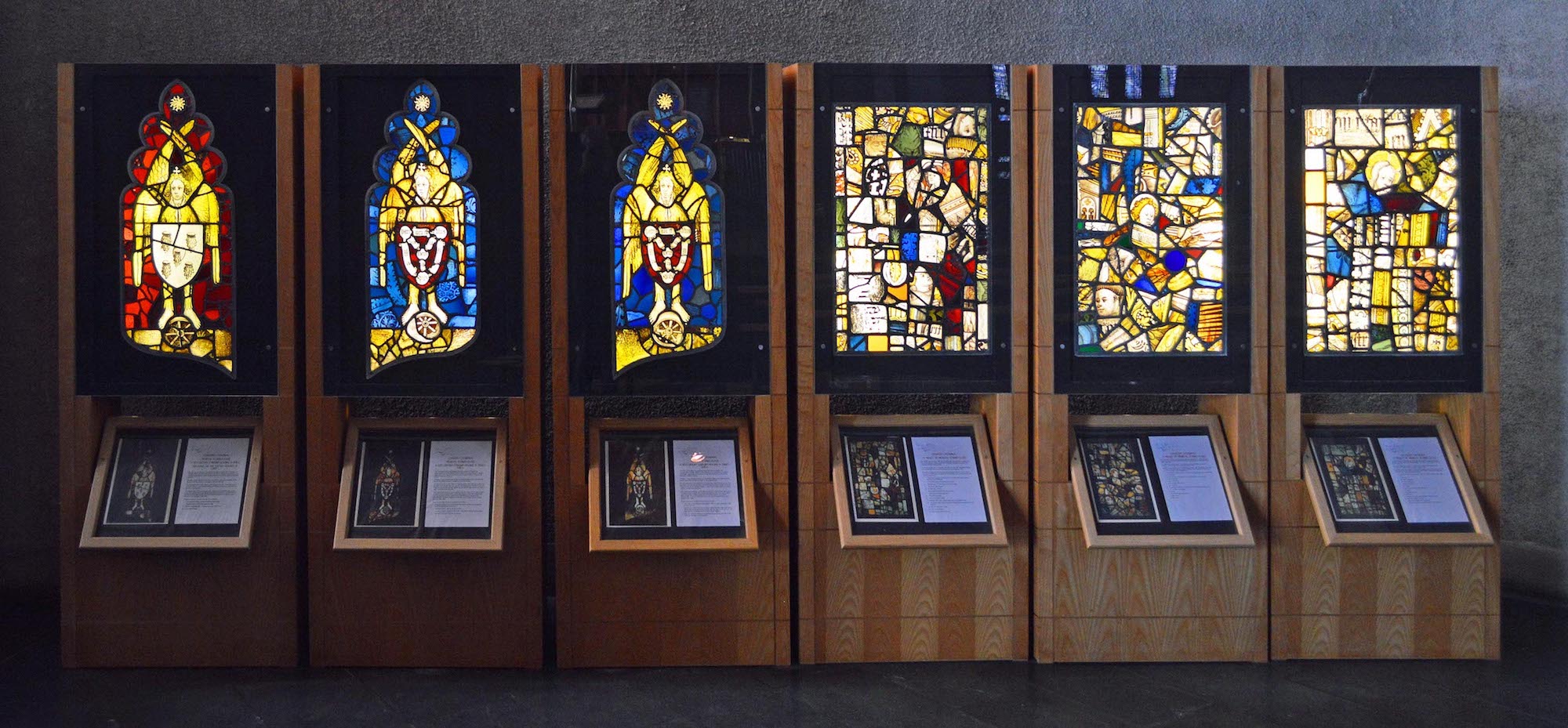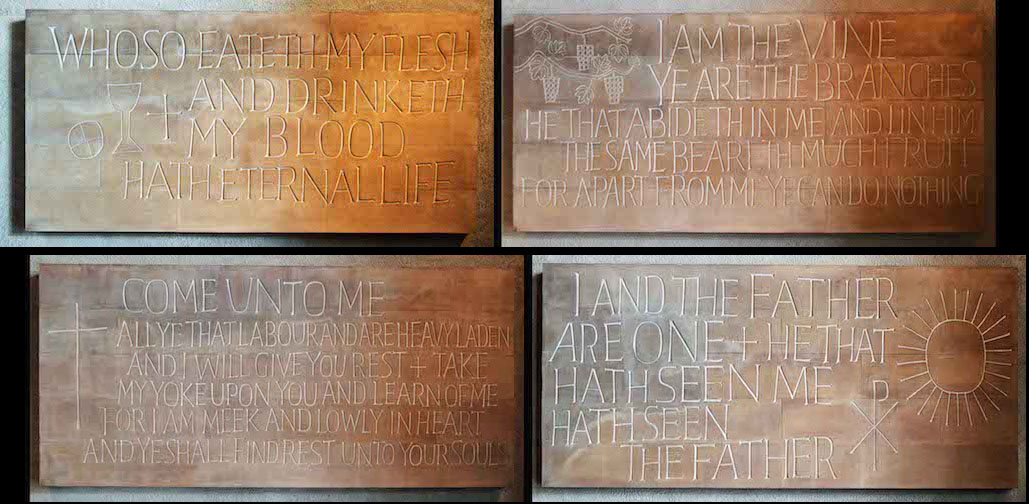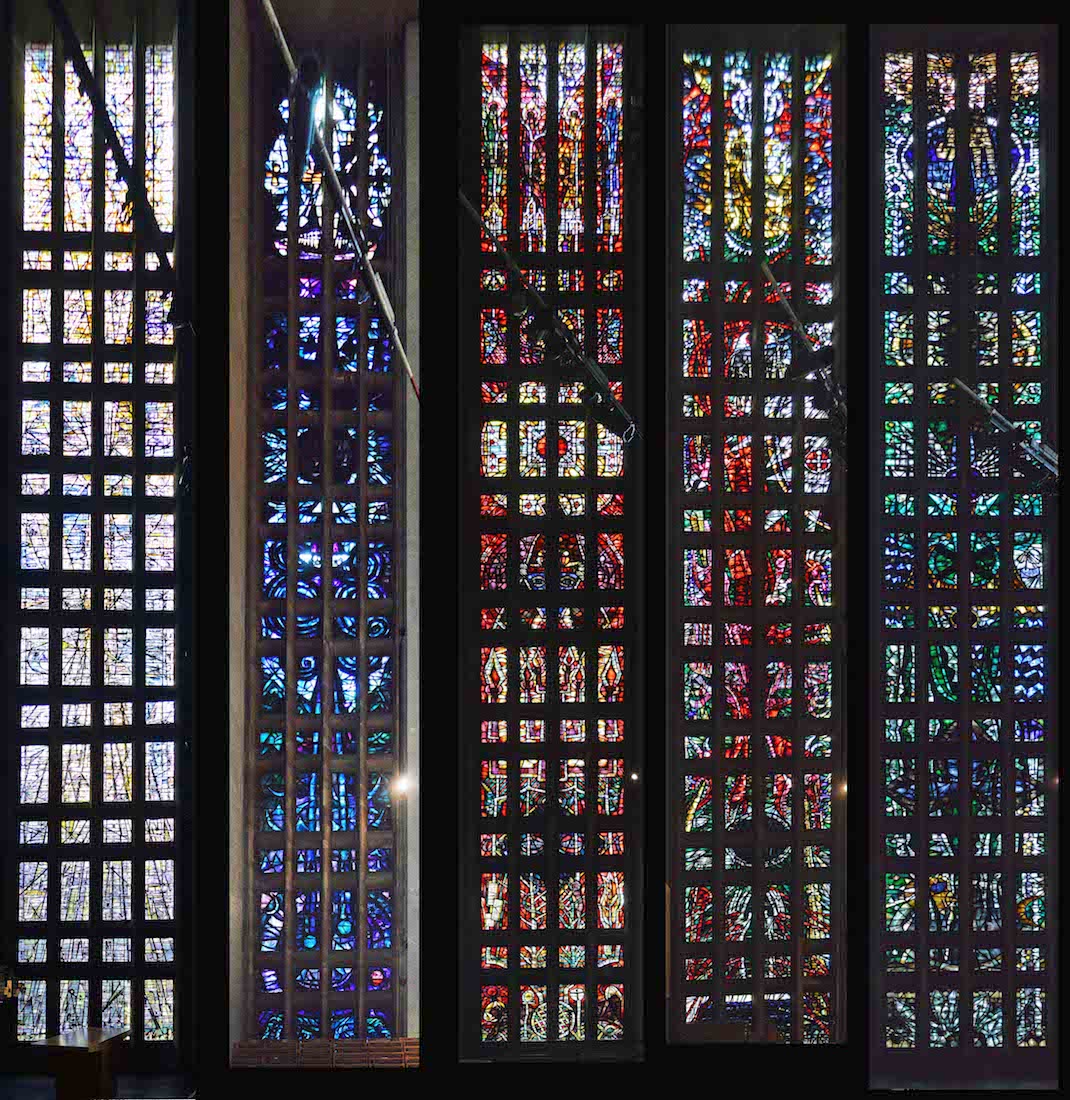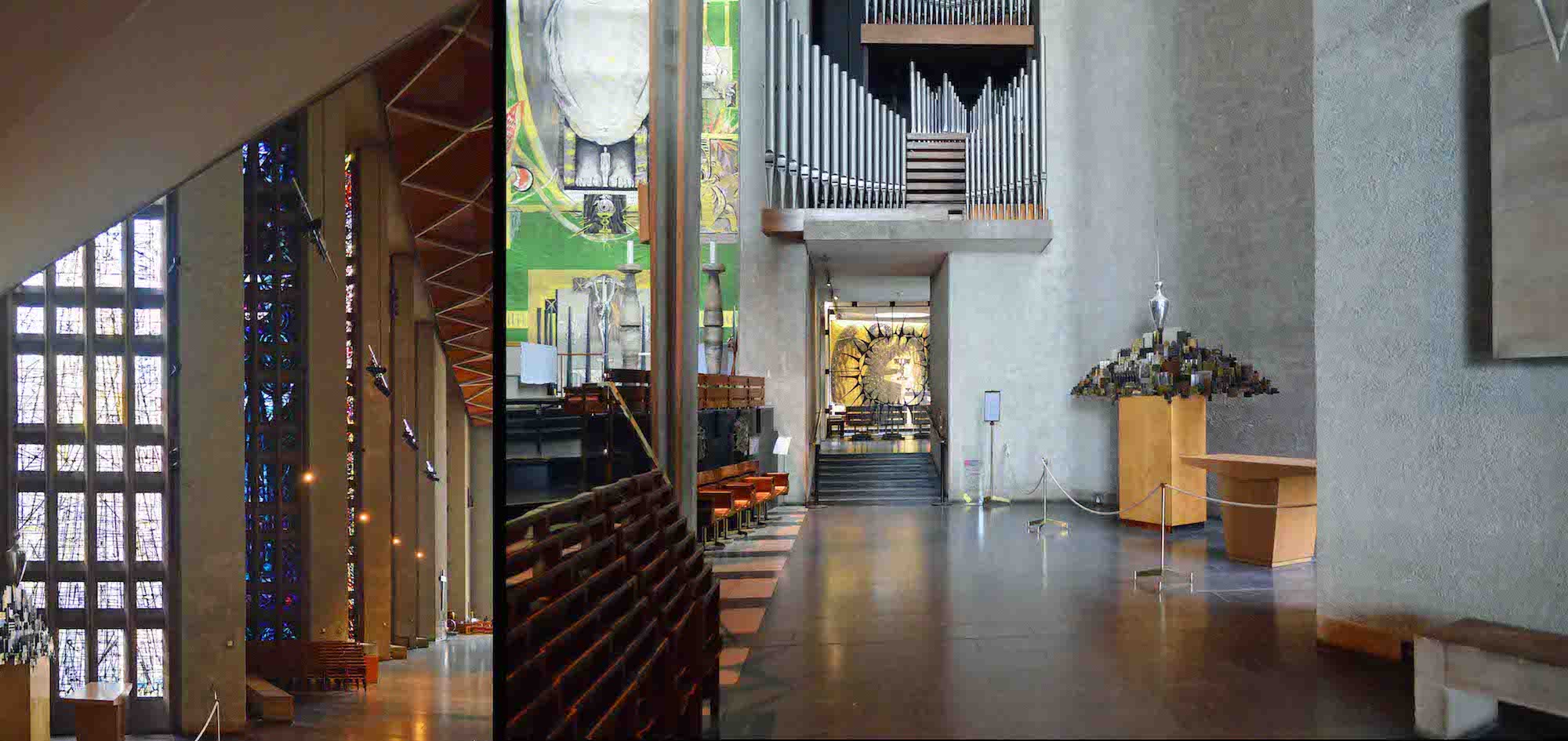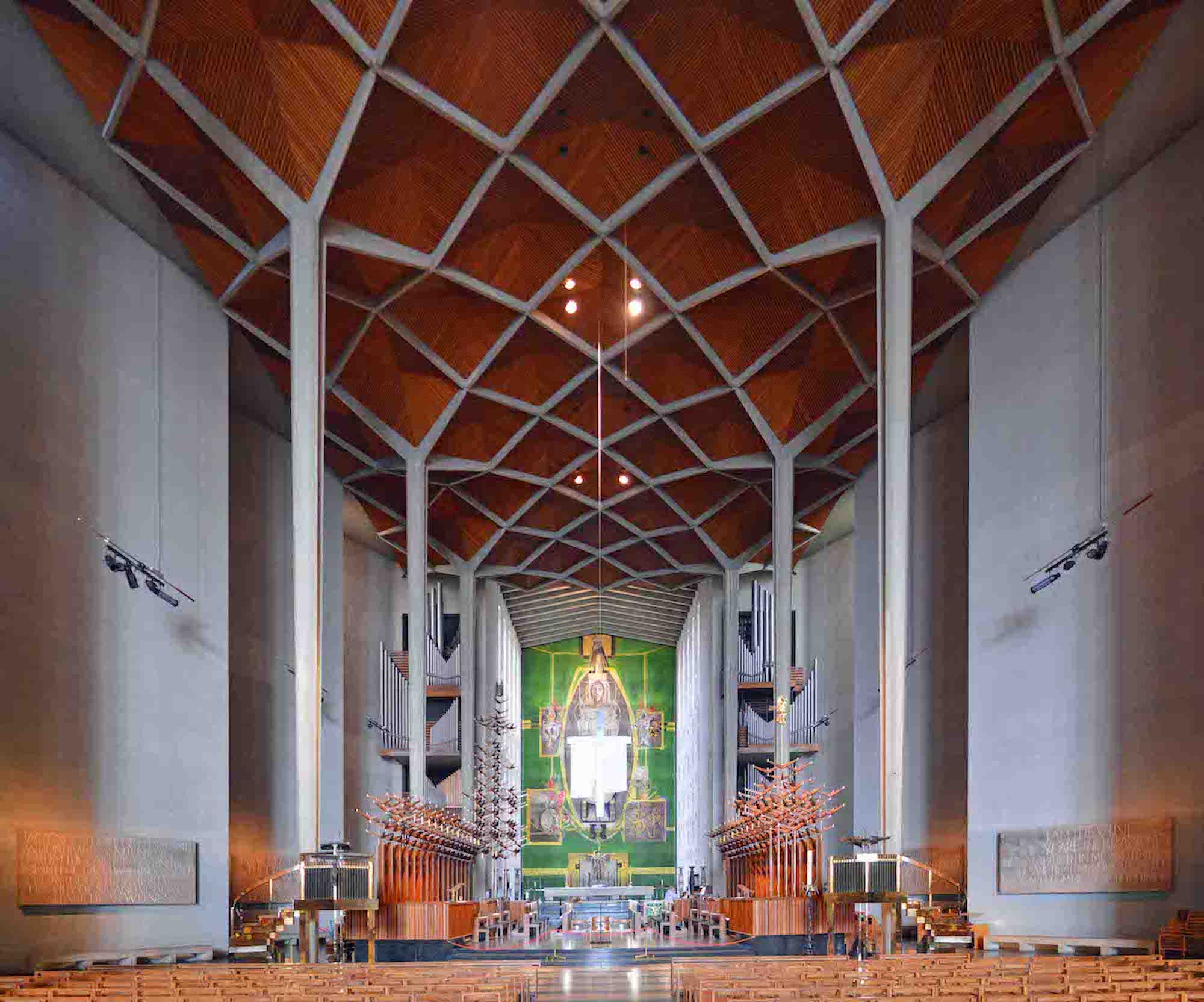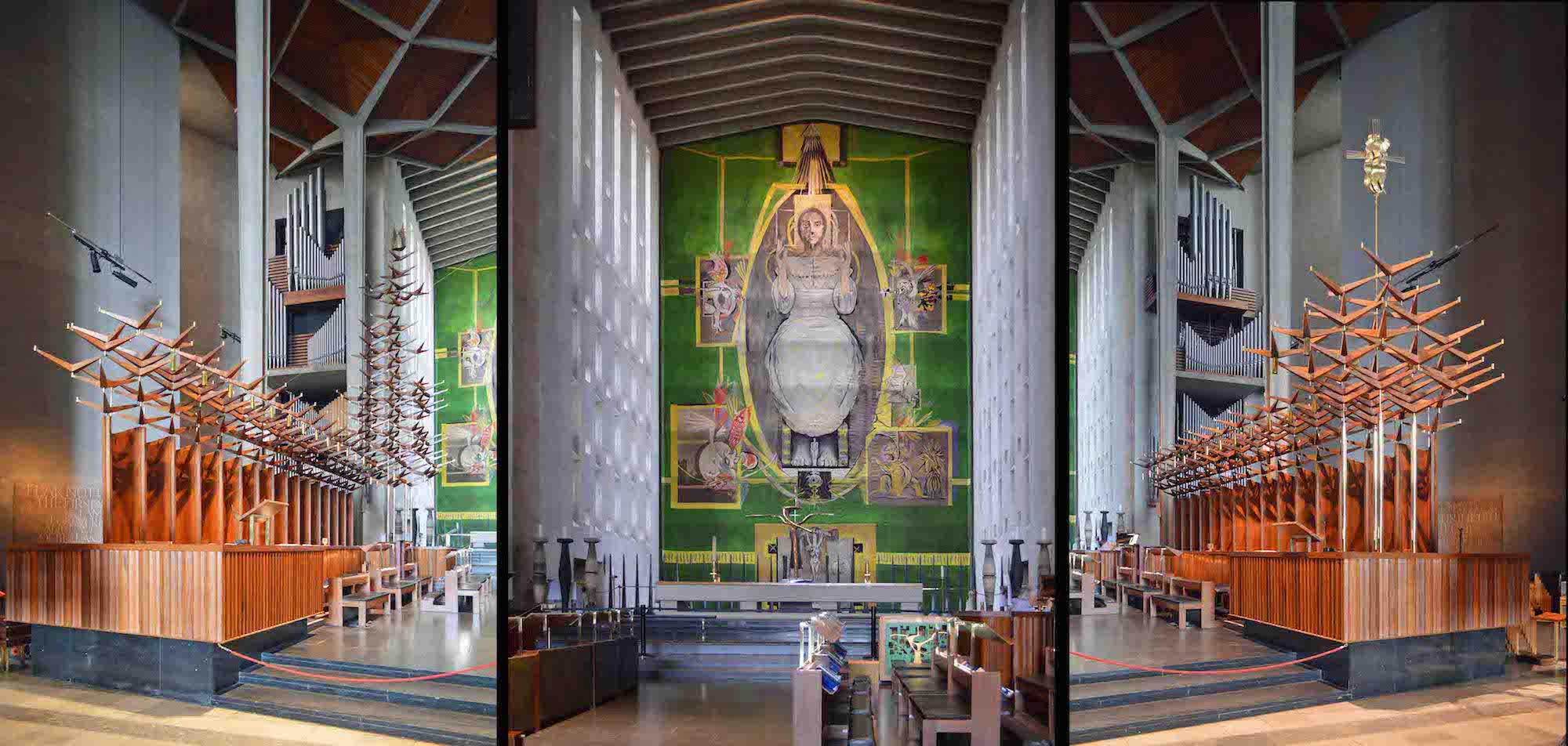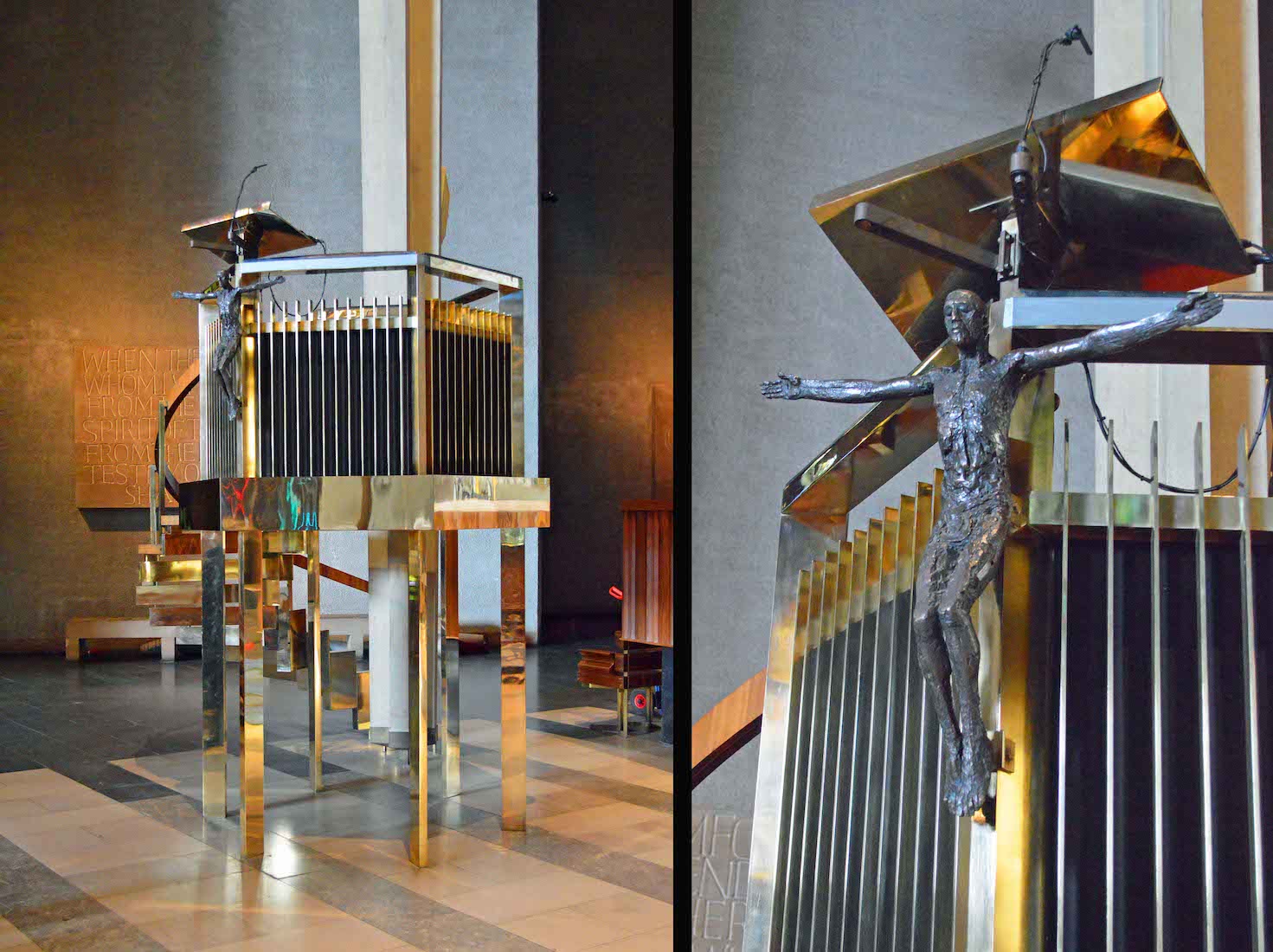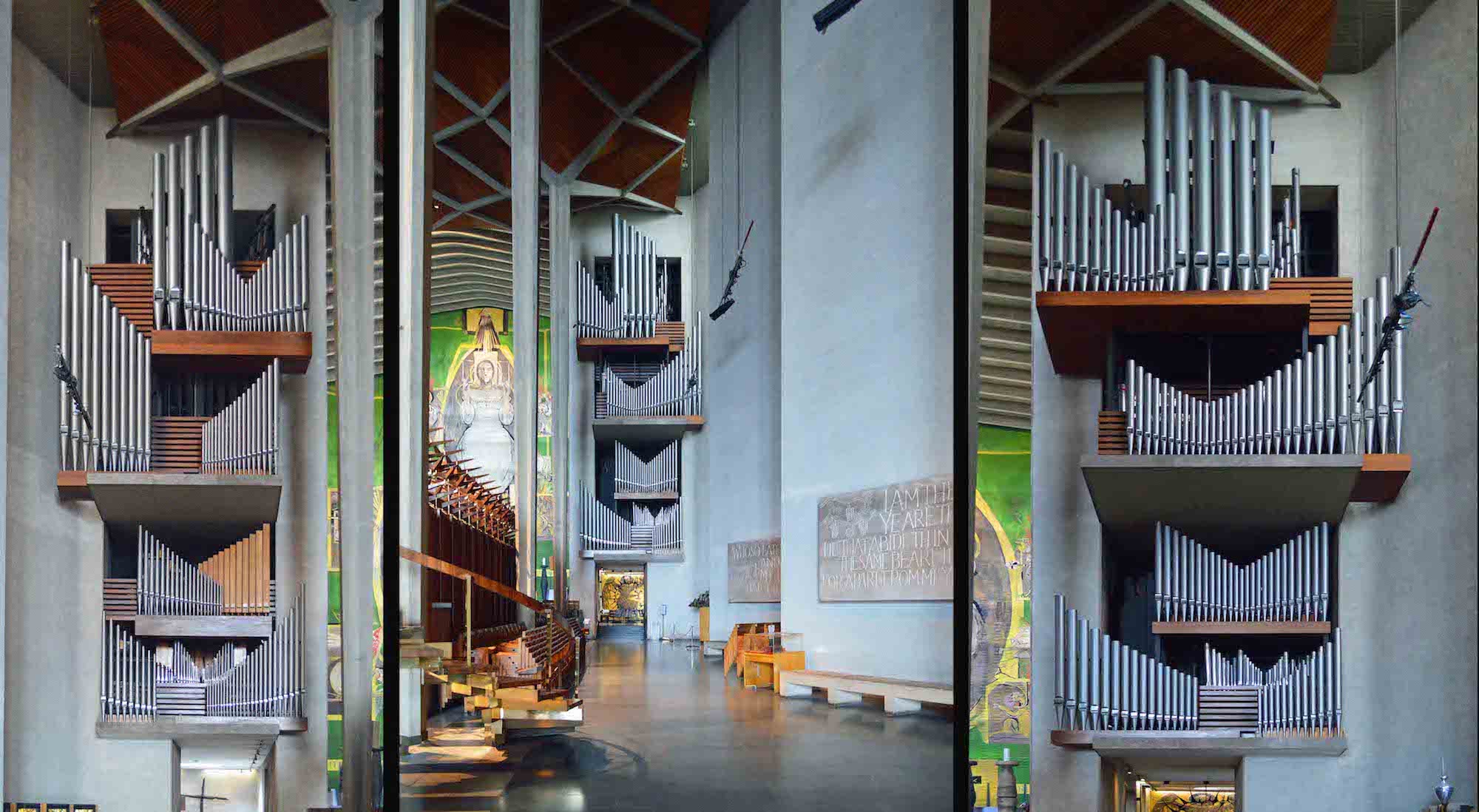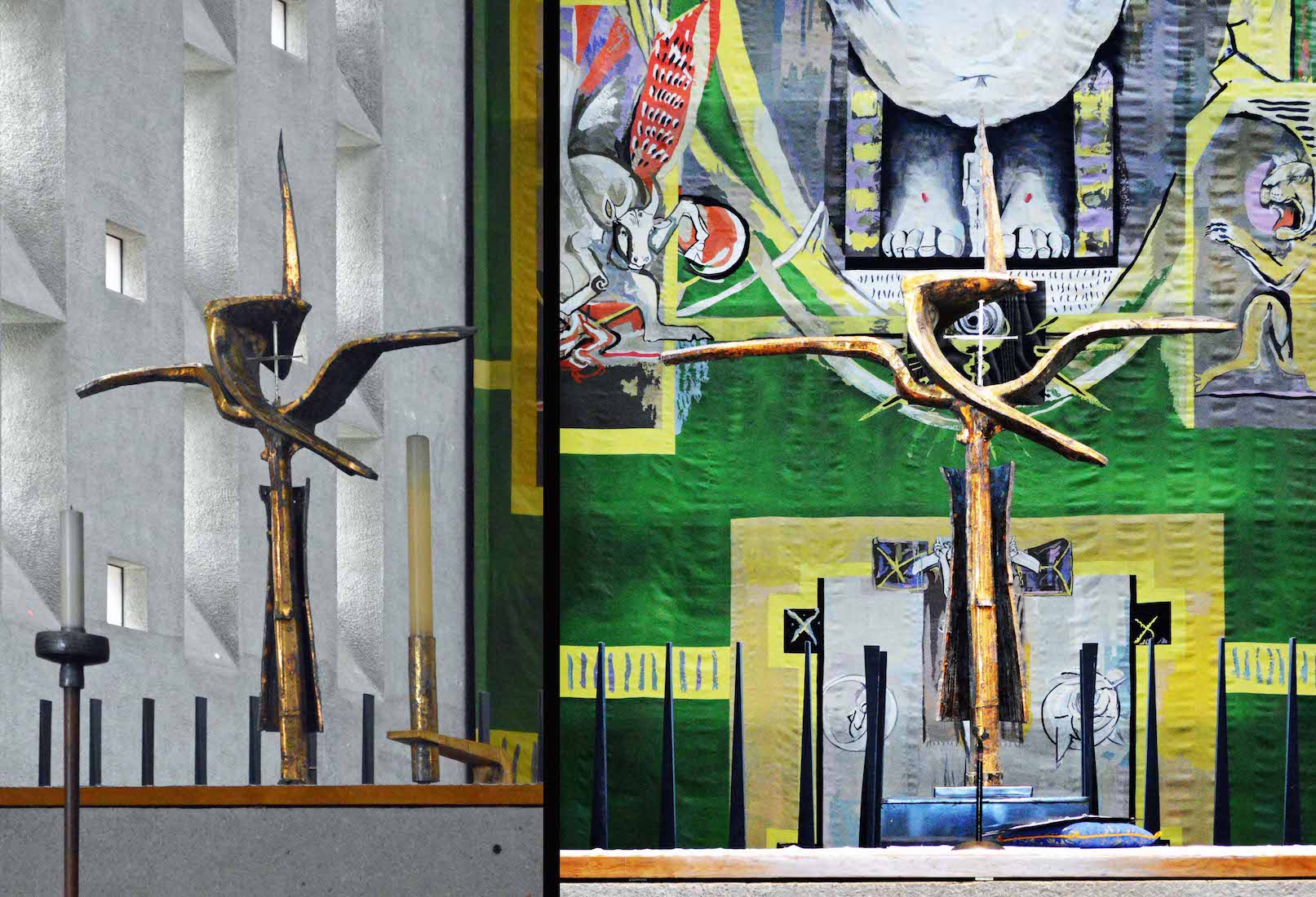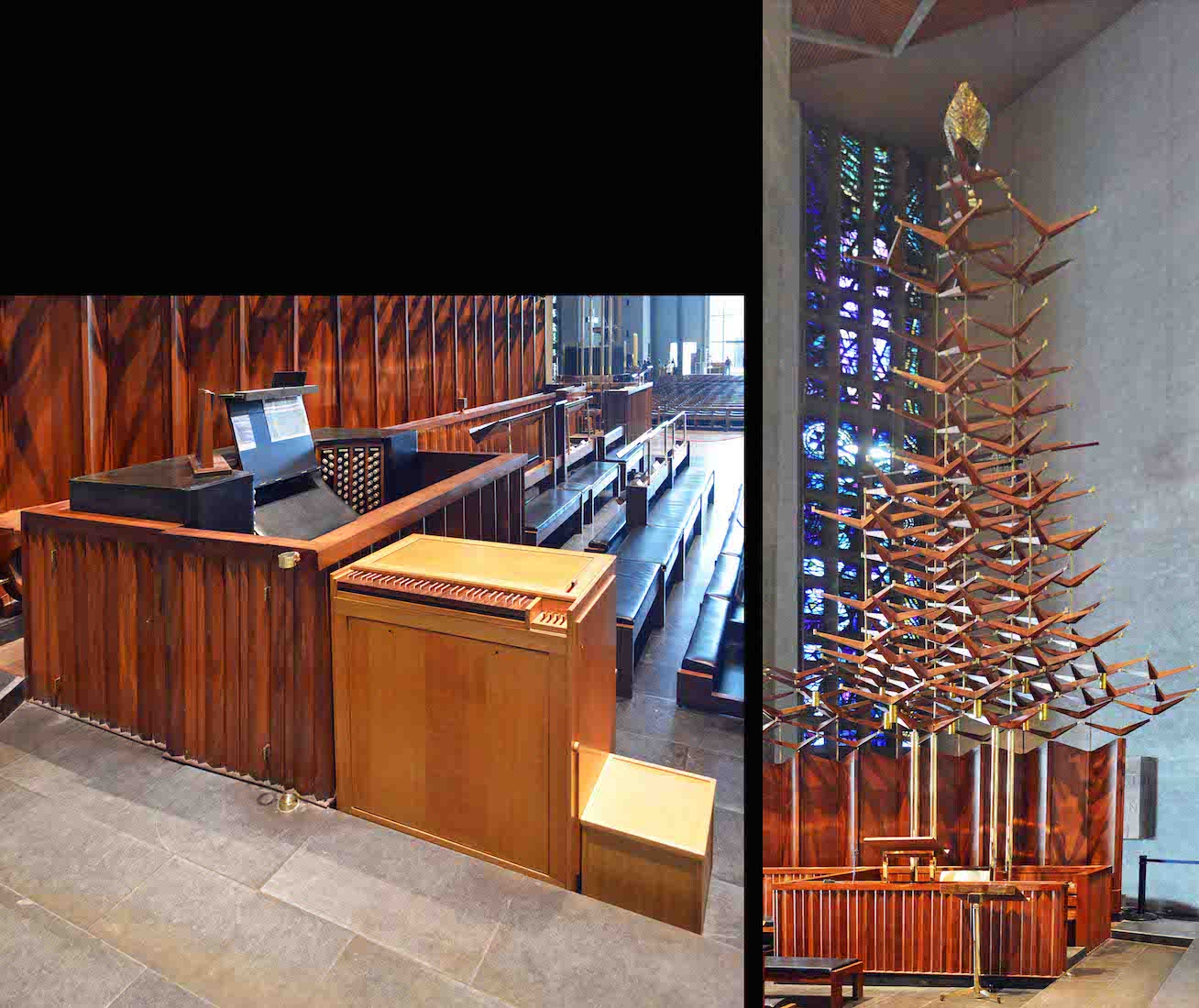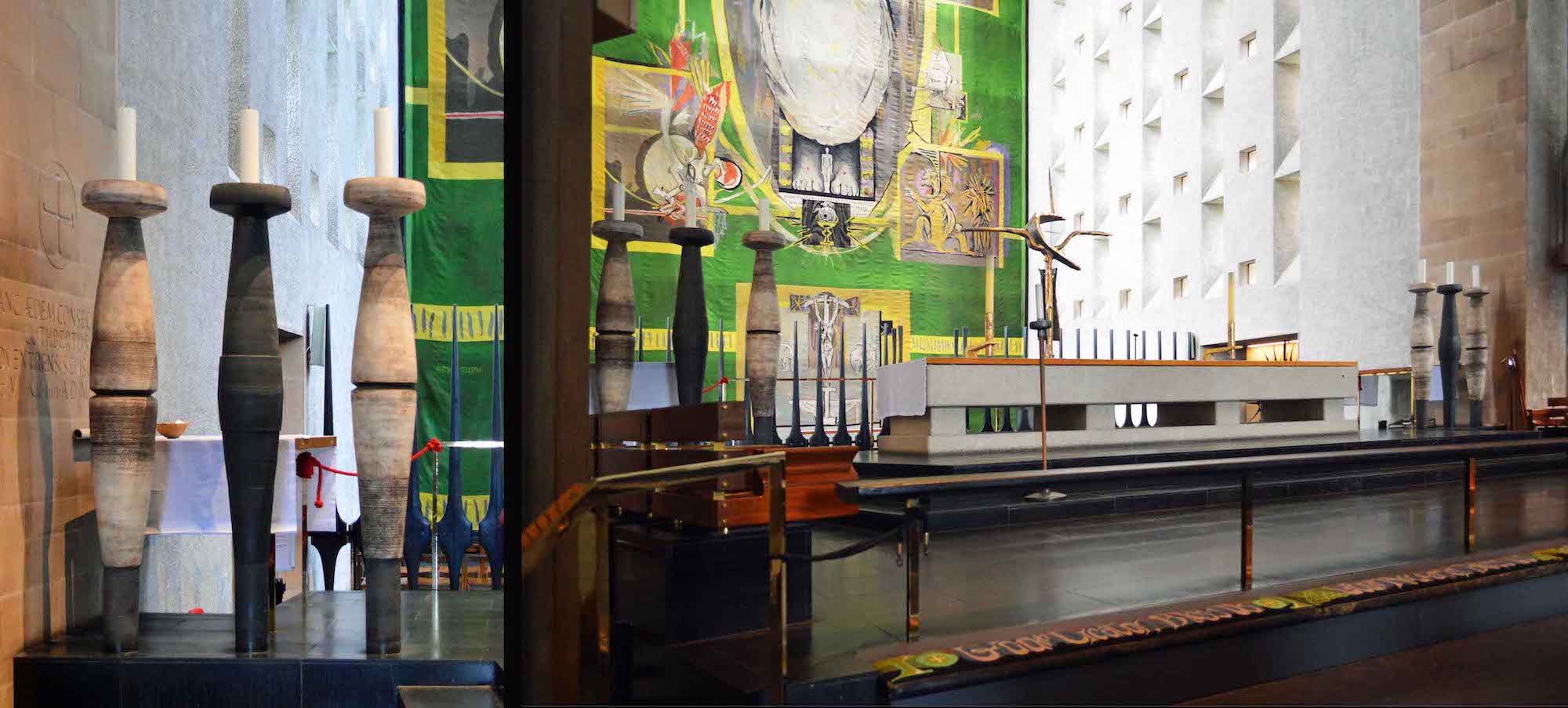34. NAVE VAULTING
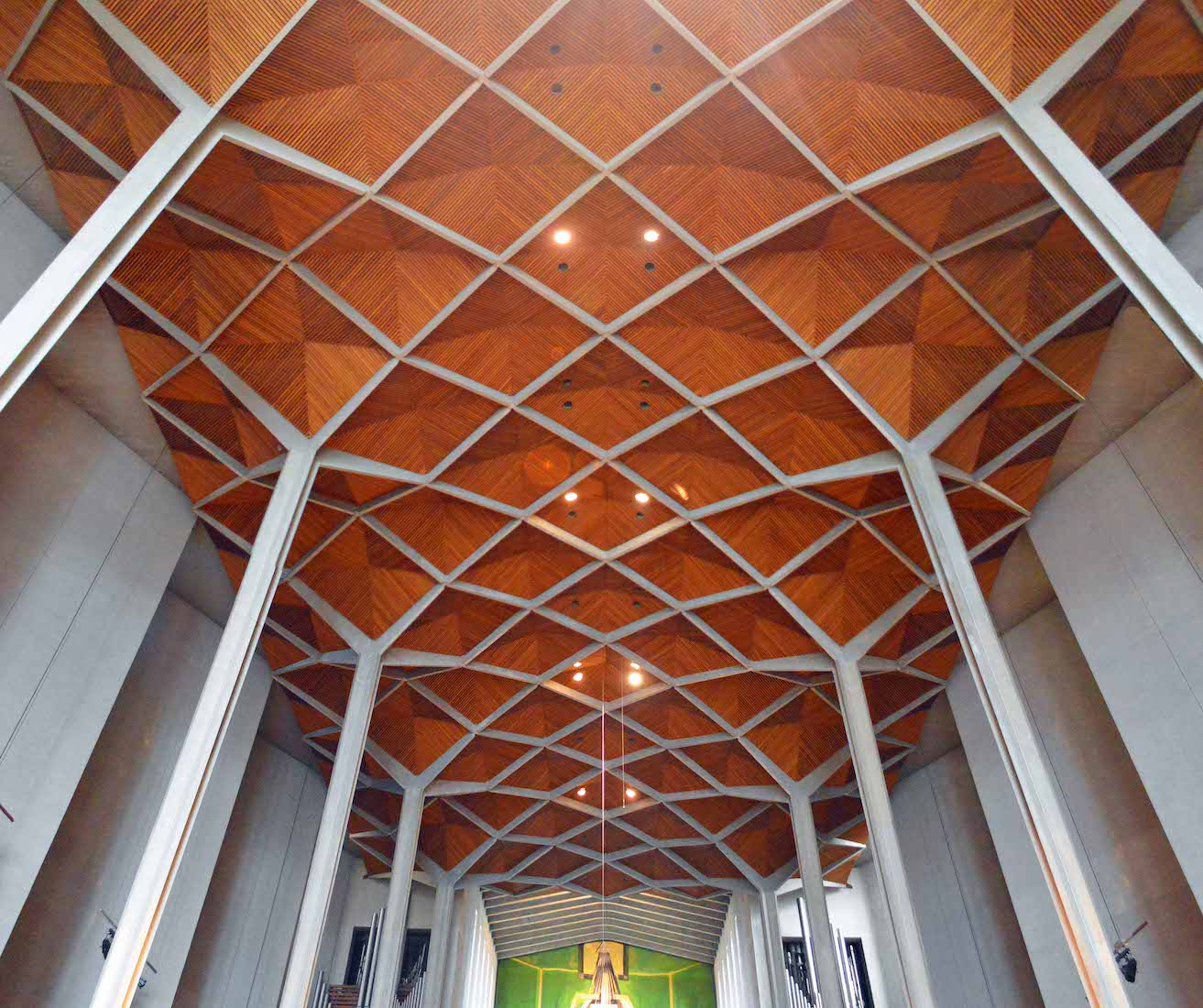
The nave ceiling is of metal and timber. Like many aspects of this Cathedral, there are echoes of the old here. We might think of the vaulting of the old Gothic cathedrals, but with a modern touch. PLAN
35. BAPTISTRY
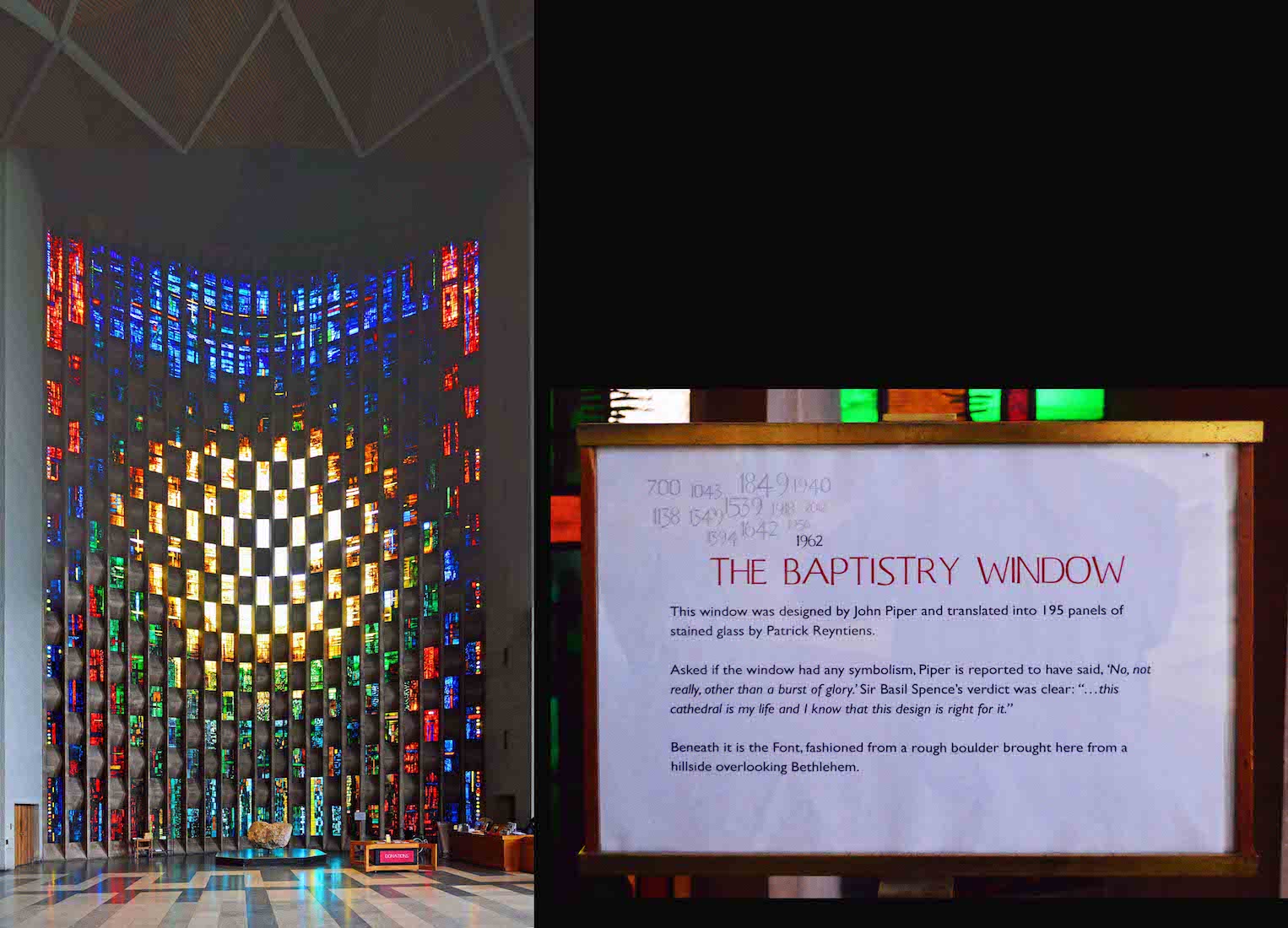
The West end of the nave is really an unusually placed minor transept. To our right (the South side) is the spectacular baptistry. The baptistry window was designed by John Piper and made by Patrick Reyntiens. It is of abstract design and occupies the full height of the bowed baptistry. It comprises 195 panes, ranging from deep outer colours to central white – a sunburst! We can think of this as a symbol of baptism itself. But there is further symbolism for us today as we pass from the ruins of the old Cathedral into the newness of life of the modern building.
36. BAPTISMAL FONT
The baptismal font is formed from a boulder from a hillside near Bethlehem. A depression in the shape of a fan-shell has been carved from the top. As baptism is seen as entry into the Christian life, so there is symbolism here with the baptistry being placed by the entrance to the Cathedral.
37. PRAYER GLOBE AND CRUCIFIX
The Globe Candlestand was made by students from Kiel, Germany. The stand holds 57 candles, which is the number of victims of the London bombings that took place on July 7, 2005, including the two bombers. The Czech Cross is a carved crucifix by Jindich Severa 1968. In the ‘70s the inscription read: ‘This crucifix is the gift of its maker, Jindich Severa. Pray for the Czechoslovak People. 1968’ This was the year Soviet troops invaded Czechoslovakia.
38. ACROSS TO THE UNITY CHAPEL
Standing here we look South to the Baptistry. But looking North we face towards the entry to the Chapel of Unity. By the entry window stands a bust at the top of a pedestal.
39. CHRIST CRUCIFIED
This bust was sculpted by Helen Huntington Jennings with metal scraps from a wrecked Volkswagen in commemoration of the destruction of the Cathedral at ‘the night of 14 November 1940, when the city of Coventry was devastated by bombs dropped by the Luftwaffe.’ The writing on the pedestal reads: ‘Christ Crucified by Helen Huntington Jennings, Norman, Oklahoma, from the metal of a crashed car. The crucifixions of man by man, in careless driving as in war, are only redeemed by love.’
40. ENTERING THE CHAPEL Of UNITY
The floor tiles in the entry show a Cross, a crown of thorns, and a chalice of wine. • The principle of a Chapel of Unity binding the Church of England and the Free Churches together for Christian service in Coventry was born out of the sufferings of war and the ecumenical enthusiasm of the church leaders. With the building of the new Cathedral, the opportunity was taken to create a purpose-built chapel. Ecumenical services are held here each week.
41. THE CHAPEL of UNITY
In 1962 there was virtually no communication between the Roman Catholics and other denominations but by 1970 the constitution of the Joint Council managing this Chapel was changed to include them on equal terms. The form conceived for the Chapel of Unity by architect Sir Basil Spence was that of a tent, the temporary home of a people always ready to move onwards.
42. THE DOVE OF PEACE
Central to the Chapel is the unifying Holy Spirit, represented as the Dove of Peace. The floor of the Chapel is subtly concave meaning that every point is tilted towards this central symbol. Visiiting school students test this with marbles!
43. THE FOUR EVANGELISTS
There are a number of symbols in the floor tiling, but most obviously the symbols of the Four Evangelists – Matthew, Mark, Luke and John. These symbols are traditional, even if their representation is not! We have: St Matthew – an angel; St Mark – a lion (the Lion of Judah); Luke – a bull (with reference to sacrifice); and St John – an eagle (with reference to Isaiah 40:31 They will soar on wings like eagles).
44. PEACE FREIDE BELL AND NORWEGIAN ORGAN
Leaving the Chapel of Unity we turn into the North nave aisle, where we first find a bell and an organ. The plaque reads: ‘This Bell inscribed in English and German with the words PEACE FRIEDE was presented to her Majesty Queen Elizabeth the Queen Mother by Richard Von Wiesacker, President of the Federal Republic of Germany during the service of reconciliation on the 50th Anniversary of the bombing of Coventry November 14th 1990’. The Norwegian Organ was a gift from the people of Norway in 1967. It was built by Torkildsen Brothers and designed by Ole Rasmus Krag. The action is mechanical.
45. NORTH NAVE TABLETS
Along the North nave wall are four large ‘Tablets of the Words’. These were carved by Ralph Alexander Beyer (1921 – 2008) who was a German letter-cutter, sculptor and teacher. There are altogether eight sandstone panels incised with quotations from the Bible and associated symbols. The texts are quotations by Jesus about himself, carefully chosen for their relevance for us today.
46. NORTH NAVE WINDOWS
When we look towards the back of the nave, we first see the colourful nave windows. There are ten main windows in the nave of Coventry Cathedral, excluding the baptistry window.
47. THE ‘HUMAN’ WINDOWS
The stained glass windows, by Lawrence Lee, Keith New and Geoffrey Clarke, face away from the congregation. Spence’s concept for these nave windows was that the opposite pairs would represent a pattern of growth from birth to old age, culminating in heavenly glory nearest the altar – the North side (shown here) representing Human, and the South side, the Divine.
48. NORTH NAVE WINDOWS PANEL
At the East end of the North nave aisle is this display of old stained glass. Glass windows from the chancel of the old St Michael's Cathedral were removed for safety at the outbreak of the 1939-45 war. After the destruction of the Cathedral in the blitz raid of November 1940, it was not possible to return the glass to the building. Some of the glass was reused in the new Cathedral, and the remainder was restored by the York Glazier’s trust, who created six glass panels which are here shown in miniature.
49. THE SOUTH NAVE WINDOWS
Looking back across the nave we see the Baptistry window and the Westernmost strip windows of the nave.
50. THE SOUTH NAVE TABLETS
The texts recorded here are from left: ‘Whoso eateth my flesh and drinketh my blood hath eternal life’ ; ‘I am the vine, you are the branches. He that abideth in me and I in him, the same beareth much fruit, for apart from me you can do nothing’ ; ‘Come unto me all ye that labour and are heavy laden, and I will give you rest. Take my yoke upon you and learn of me, for I am meek and lowly in heart, and ye shall find rest unto your souls’ ; ‘I and the Father are one; he who hath seen me hath seen the Father’ .
51. SOUTH NAVE ‘DIVINE’ WINDOWS
These are the South ‘God side’ windows. The windows were designed by Lawrence Lee, Geoffrey Clark, and Keith New, with some windows being co-designed by the artists. They were created and completed between 1953 and 1958, and then stored for later installation.
52. SOUTH NAVE AISLE
Here are a couple of ‘reconnoitering’ views. At left we stand close to the Easternmost nave window on the South side, and look back towards the baptistry. Just beyond the stacked chairs is a glass topped cabinet. For the right view we stand close to the Easternmost tablet on the South wall and look East. From left we glimpse the green tapestry, there is a view of organ pipes and an interesting chapel beyond, and then a curious sculpture.
53. PLUMB LINE AND CITY
‘The Plumb Line and the City’ by Clark Fitzgerald depicts a city with the plumb line of judgement hanging above it. The Biblical reference is found in the book of Amos, 7:7–8: ‘The Lord was standing by a wall which was built true to plumb, with a plumb line in his hand. And the Lord asked me, ‘What do you see, Amos?’ ‘A plumb line,’ I replied. Then the Lord said, ‘Look, I am setting a plumb line among my people Israel; I will spare them no longer.’ The wooden Cathedral model is in the glass topped cabinet we noticed earlier.
54. CHAIRS, SOUTH NAVE AISLE 
Opposite the plumb line sculpture is a row of chairs These are obviously for special occasions, as two of them bear coats of arms. At left is the coat of arms of the United Kingdon, with ‘Dieu et mon Droit’ written beneath (‘God and my right’ – the motto of the British Monarch). The coat of arms at right is that of Coventry. An elephant bearing three towers, a closed knight’s visor, a wild cat, and the motto ‘Camera Principis’ = the Prince’s Chamber ... . Such is history!!
56. CHOIR STALLS AND TAPESTRY
The choir stalls at Coventry are topped by a spiky wooden design. Traditionally the choir stalls are often heavily carved and decorated: I see an allusion to tradition here, but with a modern ‘take’. The tapestry of Christ in Glory, by Graham Sutherland, has hung in Coventry's cathedral since the building was consecrated in 1962. The work measures 75 x 38ft (23 x 11m) and weighs just over a tonne. The tapestry shows Christ being worshipped by the four living creatures of Revelation: a lion, an ox, a man, and an eagle (Rev 4:6–8).
57. LECTERN
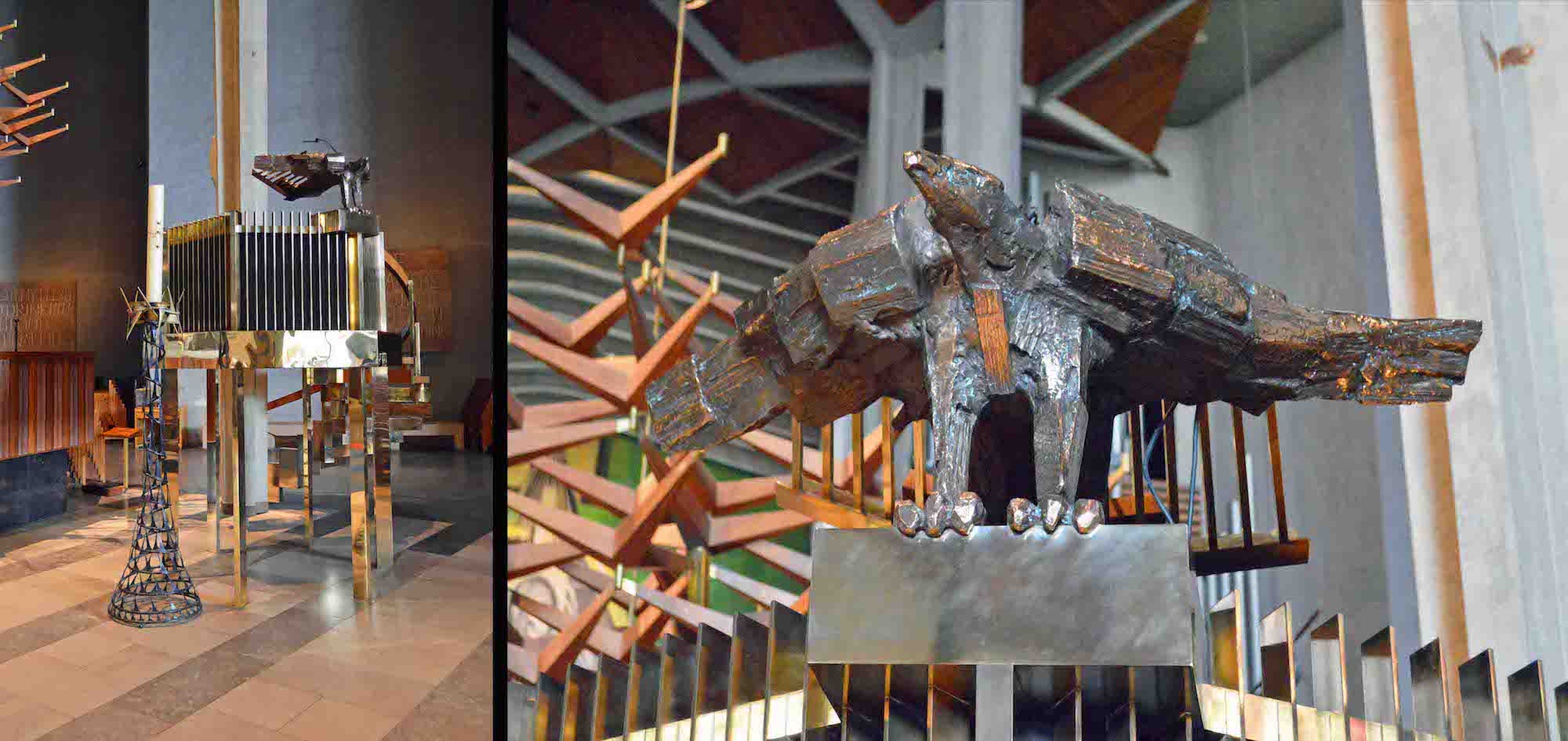
The lectern stands on the South side of the Chancel. The bronze eagle was designed by Dame Elizabeth Frink, and commissioned by Sir Basil Spence for the Coventry Cathedral lectern. Basil Spence wrote that ‘Frink ... designed and carried out a magnificent bird which looks as if it has just settled there from after a long flight.’ The eagle is commonly incorporated into the design of cathedral lecterns.
58. PULPIT
The pulpit stands on the North side of the chancel. Like the lectern, the pulpit was designed in Spence’s office by Anthony Blee. From here, sermons are delivered. Curiously, Elizabeth Frink’s gilded copper representation of Christ crucified features no cross!
59. THE ORGAN
The original Cathedral organ was completely destroyed in the air raid in November 1940. The building of the new Cathedral presented the opportunity for a brand new organ to match it. Organ builders Harrison & Harrison were appointed in 1952. The present organ is a compromise of two extreme views on organ building in the 1950s, but is regarded as one of Harrison and Harrison’s greatest instruments. It fulfils the many demands placed on it admirably, and there are many who hold it in high regard. The pipes can be seen at the Eastern end of the nave aisles.
60. HIGH ALTAR CROSS
The high altar Cross is made from silver and plated with gold; it is an abstract work representing a phoenix rising from the ashes. At its heart is the original ‘cross of nails’, formed by 3 medieval nails which were part of the old cathedral’s roof. This Cross of Nails inspired the ministry for Reconciliation and Forgiveness based in the Cathedral today.
61. ALTAR VIEW OF THE NAVE
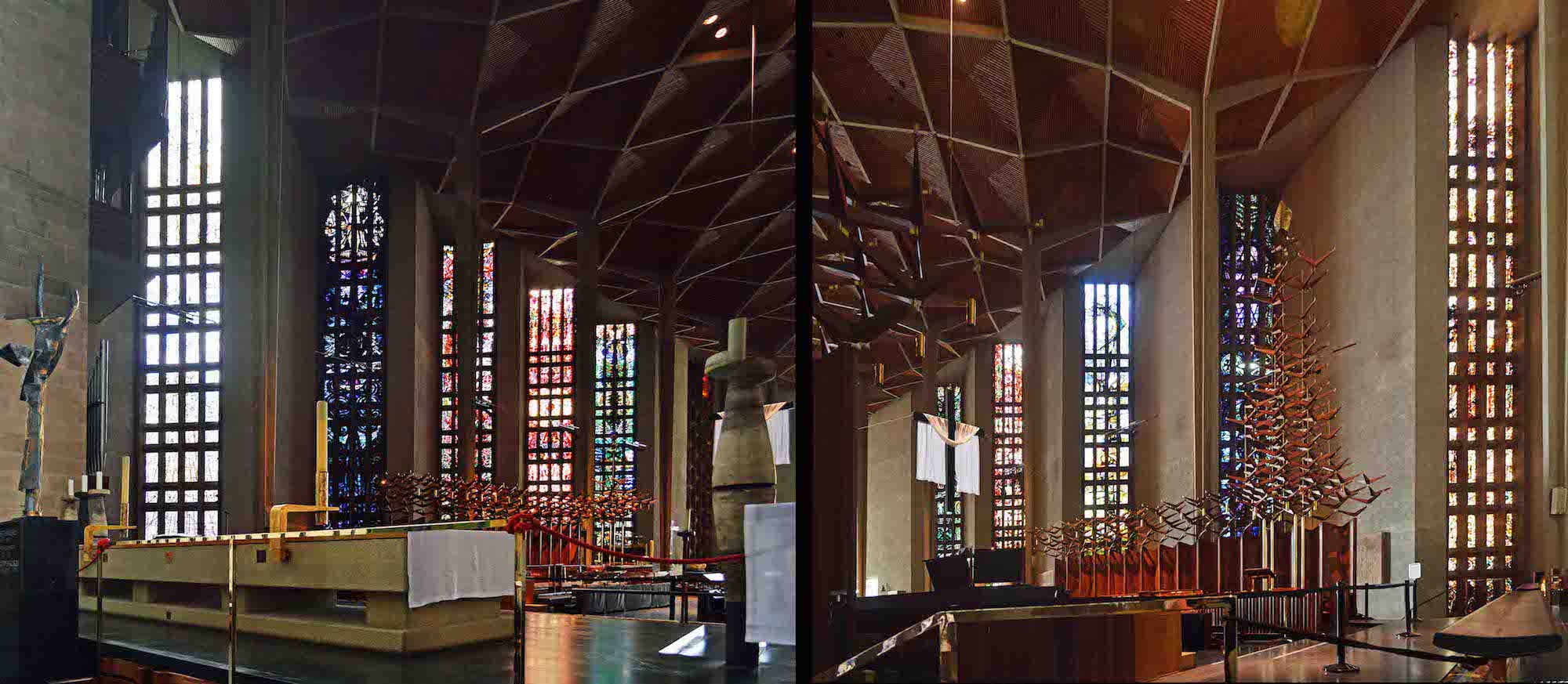
How different the nave looks from the altar! Instead of a somewhat sombre view, the windows give a blaze of light and colour.
62. ORGAN CONSOLE AND CATHEDRA
From the high altar we get a good view of the organ console with its four manuals and many stops. On the North side is the cathedra, or bishop‘s seat. Again there is an allusion to the highly decorated Gothic cathedra, here surmounted by a bishop’s mitre.
63. CANDLE STICKS AND HIGH ALTAR
The high altar is huge, modern and made of concrete. On either side is a set of unusual candlesticks. These are the work of the German born British studio potter Hans Coper (1920-1981). Basil Spence writes: ‘After much thought and talk ... we decided to ask Hans Coper to do [the candlesticks] in pottery. Perhaps this may start something as I have not seen pottery candle-holders in churches. My aim was a strong robust object about seven feet tall in scale with the huge concrete altar.’
64. ALTAR KNEELERS
The attractive kneelers across the front of the high altar read: God the Creator bless us • God the Redeemer bless us • God the Sanctifier bless us • Bless us in our family • Bless us in the world • Bless us in our community. This completes our investigation of the Western section of the Cathedral, so we go down the Northeastern stairs to the Cathedral café for a well deserved coffee break!
65. THE STALINGRAD MADONNA CHAPEL
Suitably refreshed we return. Part way up the stairs is this Chapel – the Millenium Chapel of the Stalingrad Madonna. This Chapel is a special place to pray for prisoners of conscience, those who have been imprisoned because of their faith or political views. It is the most modern addition to the Cathedral, with names engraved on the glass screen to commemorate loved ones. The sketch of Mary and Jesus was drawn on the back of a military map by a German army surgeon, under siege in Stalingrad in 1942.
66. CHARRED CROSS
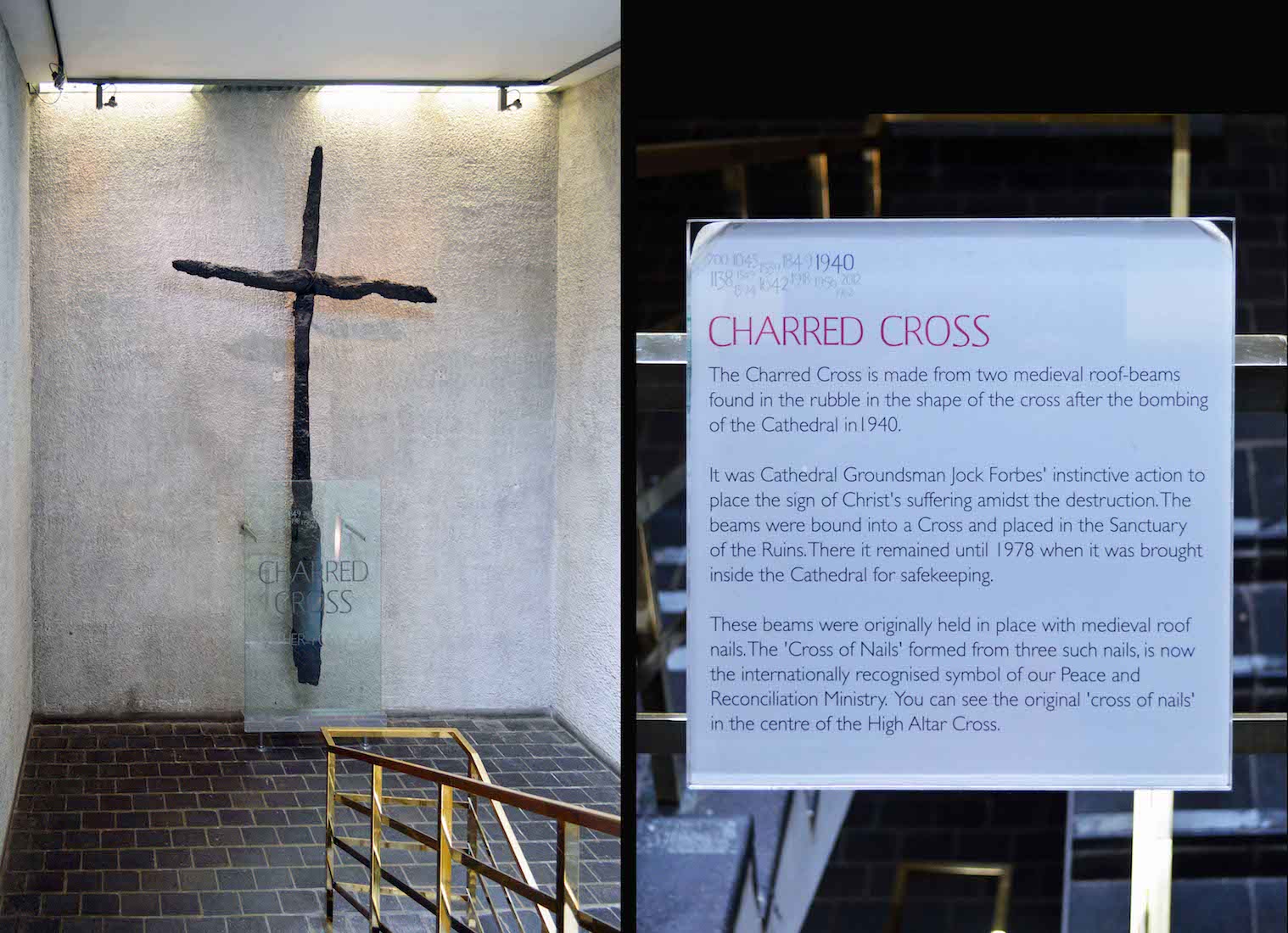
Further up the stairs we come to the Charred Cross. This was created after the old Cathedral was bombed during the Coventry Blitz of the Second World War. The cathedral stonemason, Jock Forbes, saw two wooden beams lying in the shape of a cross and tied them together. This is the original Charred Cross.



